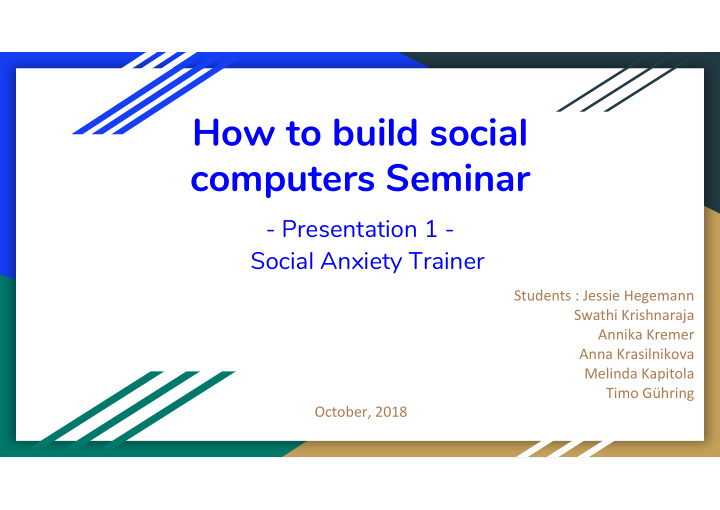



How to build social computers Seminar - Presentation 1 - Social Anxiety Trainer Students : Jessie Hegemann Swathi Krishnaraja Annika Kremer Anna Krasilnikova Melinda Kapitola Timo Gühring October, 2018
What is Social Anxiety? Social anxiety disorder (also known as social phobia) is defined by the core feature of excessive fear of embarrassment , which is often accompanied by avoidance of social or public situations (Schneider, Blanco, Antia & Liebowitz, 2002).
The need of a Social Anxiety Trainer - Prevalence rate 13-14% - Challenge yourself - Improves all parts of your life - Gives you motivation - Easily accessible
What are treatments for Social Anxiety in a clinical context? Cognitive Exposure Restructuring Relaxation Social Skills Training Training
The Idea: Social Anxiety Trainer Target group: Adults with mild levels of social anxiety Goal: Decreasing level of social anxiety General idea: 1. Based on the level and categories of his/her social anxiety, the app picks a task 2. Monitoring voice and heart rate during the task 3. Interaction with the community and feedback
The Idea: Social Anxiety Trainer Workflow: 1. Initial questionnaire 2. Tutorial 3. A task with an adequate level of difficulty will be selected 4. User performs the task 5. The mobile app monitors voice and heart rate 6. After the task the user should rank the comfortableness of the challenge 7. Feedback
The Workflow : Social Anxiety Trainer App
The Workflow : Social Anxiety Trainer App Structured Questionnaire Allocate tasks to users Provide feedback ● Questions will be ● Based on appropriate ● Heart rate and voice structured based on difficulty level of the data will be monitored various social anxiety user under each categories category ● Statistical data analysis results are displayed to ● Each question will ● Each task - Option A /B the user evaluate how good the can be chosen user is under a ● Motivational and particular category Gradually difficulty of constructive feedback ● the task increases ● Classify the difficulty level based on users responses
Categories Performance Interactional based - Meeting new people - Test anxiety - Talking to strangers - Public speaking - Going on dates - Going to work or school - Asserting oneself - Sports performance → Call your doctor and make an appointment → Present a topic you like in front of two friends → Talk to a stranger and ask them for a favor → Solve a task and stop the time
Categories Indirect social situations → Wash your hands in a public - Using public restrooms restroom - Eating in front of other people - Being watched while doing → Eat lunch in the cafeteria something - Being the center of attention - Shopping
Community General community → access from the start - - User can decide if it is anonymous or not - Exchange experiences and achievements - Rewards
The Idea: Social Anxiety Trainer Technology Setup ● Android mobile app ● Microphone support ● Emotional recognition for voice streams (audEERING) ● Smartwatch support for heart rate ● IDE: Android Studio
The Idea: Social Anxiety Trainer Related Work ● Miloff A., Marklund A., Carlbring P., 2015. The challenger app for social anxiety disorder: New advances in mobile psychological treatment Internet Interventions 2 (2015) 382-391 ● Developed at the Stockholm University Department of Psychology ● Gamification ● General approach (different skill categories) ● Activity Tracking (Location), but no monitoring of voice/ heart-rate
To-Do ● Add more/define more concrete categories/challenges ● Divide categories and challenges into different difficulty levels ● Create the initial questionnaire based on the categories and difficulty levels ● Building a forum/community ● Provide Statistical Analysis and Feedback: how to implement positive reinforcement
Thank you!
References Gebhard, P., Schneeberger, T., Andre, E., Baur, T., Damian, I., Mehlmann, G., . . . Langer, M. (2018). Serious Games for Training Social Skills in Job Interviews. IEEE Transactions on Game s, 0(0), 1-13 Grabhorn, R., Stenner, H., Stangier, U., & Kaufhold, J. (2006). Social anxiety in anorexia and bulimia nervosa: the mediating role of shame. Clinical Psychology & Psychotherapy , 13 (1), 12–19. Heimberg, R. G. (2002). Cognitive-behavioral therapy for social anxiety disorder: current status and future directions. Biological psychiatry , 51 (1), 101-108. Heimberg, R. G., Hofmann, S. G., Liebowitz, M. R., Schneier, F. R., Smits, J. A., Stein, M. B., ... & Craske, M. G. (2014). Social anxiety disorder in DSM-5. Depression and anxiety , 31 (6), 472-479. Miloff, A., Marklund, A., & Carlbring, P. (2015). The challenger app for social anxiety disorder: New advances in mobile psychological treatment. Internet Interventions , 2 (4), 382–391. Schneider, F. R., Blanco, C., Antia, S. X., & Liebowitz, M. R. (2002). The social anxiety spectrum. Psychiatric Clinics of North America , 25 (4), 757-774.
References Spence, S. H. (2003). Social Skills Training with Children and Young People: Theory, Evidence and Practice. Child and Adolescent Mental Health , 8 (2), 84–96. Eyben, F., Weninger, F., Gross, F., & Schuller, B. (2013). Recent developments in openSMILE, the munich open-source multimedia feature extractor. Proceedings of the 21st ACM international conference on Multimedia - MM '13 , , 835–838. https://doi.org/10.1145/2502081.2502224
Recommend
More recommend